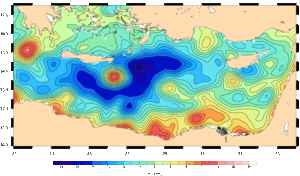Mesoscale ocean applications
Ocean currents are sometimes compared to 'sea highways', because ships follow their flow to gain speed. But this picture is not wholly accurate. In fact, ocean currents are more like secondary roads branching off into narrow country roads and lanes, winding their way around hills and natural obstacles. The main flow of these currents is often disturbed by eddies that form at their edge. So the ocean is really more like a vast, slowly swirling whirlpool bath than a swimming pool divided into perfectly straight lanes.
The mesoscale circulation is defined like a class of energetic phenomena of spatial scales ranging from about ten to several hundred kilometers and time scales ranging from a few days to several months. Its forcing mechanisms are mainly instabilities from the large-scale circulation and interactions between currents and bathymetry and the direct forcing by the wind.
Altimetry enables to observe such phenomena by measuring hills and valleys around which currents swirling. A best resolution is obtained with several satellites to study and understand eddies, with sizes ranging from 100 to 300 km (when the ground track separation at equator is about 315 km for Jason). The existence of at least two satellites operating simultaneously is therefore necessary for this type of research. For operational applications, three, or even better, four operational satellites at the same time are required.
Some examples using altimetric data applied to the mesoscale circulation :
- Some eddies as seen by altimetry on Google Earth (Download the kml file and open it in Google Earth).
- Lively data
- November 2003 :Different points of view.
- July 2003 :North Atlantic eddies.
- March 2007 :Cool Australian eddies.
- August 2007 :The Alboran eddies.
- Radar Altimetry Tutorial, data use case : Ocean eddies as seen by satellite altimetry : the Kuroshio current.





